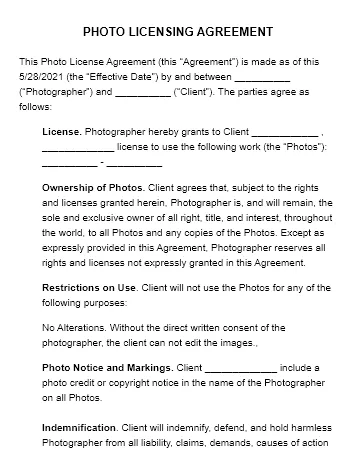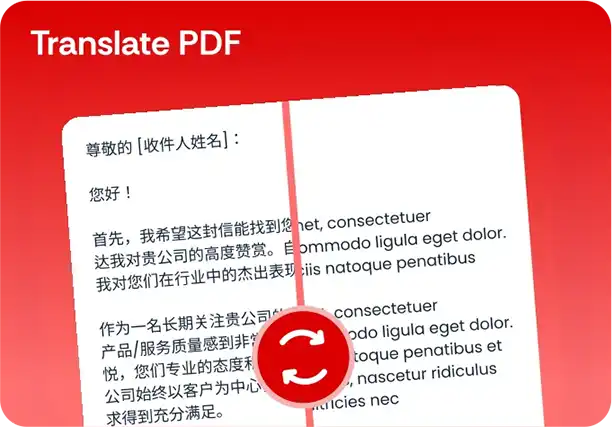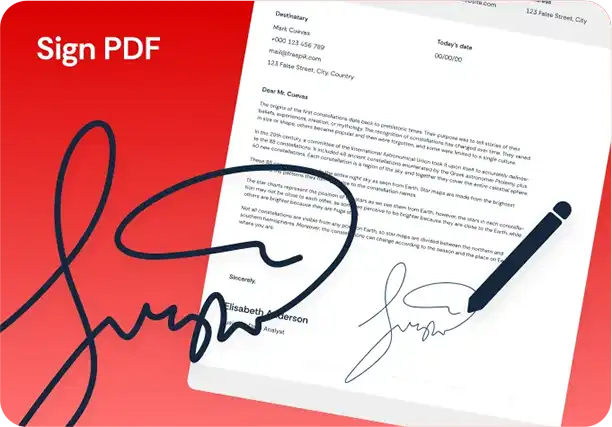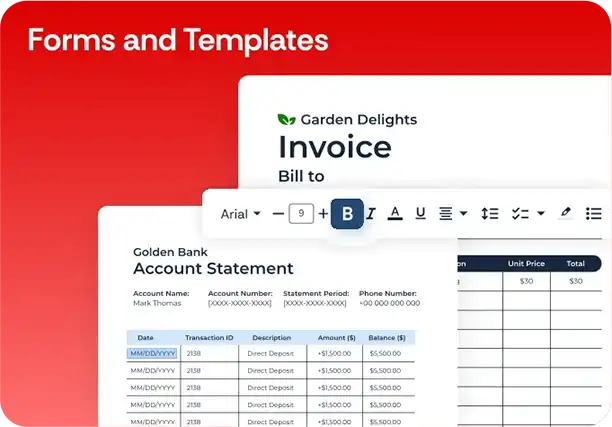Photo Licensing Agreement Template
Stop searching and find out why people love the ease of creating beautiful and legally compliant Photo Licensing Agreement with PDFSimpli.

Stop searching and find out why people love the ease of creating beautiful and legally compliant Photo Licensing Agreement with PDFSimpli.


Pick from the colors and templates below
To Whom it May Concern:
I, ____________________, is the legal guardians of ____________,
born ________.
To Whom it May Concern:
I, ____________________, is the legal guardians of ____________.
To Whom it May Concern:
Guardian Information. We, _____ and _____, are legal guardians of _____.
Travel Consent. Child has permission to travel with _____.
Medical Authorization. We authorize necessary medical treatment.



If you have ever created or used commercial photos, then you may have come across a photo licensing agreement before. Websites that provide free photos for commercial use generally post a small notice that you automatically agree to when you use the photo. This may or may not include crediting the photographer or model. On paid websites or when contracting paid photography services, the photo licensing agreement is more detailed. It also requires an explicit agreement.
Photo licensing agreements constitute a contract between the entity that owns the intellectual property rights and the entity that wants access. Sometimes, the entity is a person, but it may also be a business or brand. The contract details the terms of use for the licensed material. This may include digital files or physical prints. The license agreement may also take place directly or via a third-party platform.
Some people extend photo licensing agreements to cover other types of licensed content, such as vectors, photo-manipulations, illustrations, basic infographics, and videos. Legally, these works tend to receive the same intellectual property protections as photographs do. Because of this, photographers who also create these works may only use one photo licensing agreement to cover everything.
The most important use of a photo licensing agreement is to ensure visual creators maintain ownership of their works. It prevents other artists or brands from using the work as part of their own creations without giving something in return, such as a photo credit, use of the logo or payment.
Photo licensing agreements also help photographers prevent their works from becoming part of projects they do not wish to be associated with. For example, some photographers only make their works available for editorial pieces, such as newspaper content. Others might prevent the use of their works in content related to religion, politics or other touchy topics.
Once a photographer takes a photo, it belongs to him or her. This person has the right to seek compensation if someone uses that work without permission, especially for a controversial or commercial purpose. Image licensing agreements establish legal ownership and increase the likelihood of appropriate usage and payment.
Even if you are only a hobby photographer, it might surprise you how many brands may reach out for permission to use your photograph. Create a photo licensing agreement just in case.
Models have some ownership over their image and likeness but do not have the same rights as photographers. You may use a photo licensing agreement to complement your model release to establish ownership.
Visuals play a crucial role in marketing and PR. You need photo licensing agreements to present to smaller or amateur photographers who may not immediately have one at the ready.
If you are the photographer, why do you take photos and why would you allow anyone to use them? This is the first question you need to answer before moving forward. If you only take photos for fun, you might not care much about money. Getting credit for your work may help you build a platform. If you plan to make a living from photos, however, payment should be part of your contract.
If you are the photographer or the model, what are your values and how will your allowed photo usage tie into this? If you feel more connected to your work, you may not want it involved with certain subject matters or brands. This is especially important if you included other brand symbols in your photo, such as a clothing line you own, a book you published, or your face.
If you feel you are not up to the task of writing an agreement on your own, you can seek legal counsel. Note that this is likely to be the most expensive route. Most attorneys charge by the hour. A more economical alternative is to use a template that meets your state’s requirements. You can then edit the template to include this and other information you may need:
The intellectual property owner or licensor
The entity purchasing licensing rights or licensee
Accompanying model releases, where applicable
Details of the intellectual property
The jurisdiction that governs the contract
Length of use or number of uses
Allowed purposes
Compensation (Licensing fee, credit, etc.)
Permission to use owned trademarks that appear in the photo, such as logos
1 What Is a Photo Licensing Agreement?
2 What is a Photo Licensing Agreement used for?
3 Why should you use a Photo Licensing Agreement?
3.1 You Are a Photographer
3.2 You Are a Model
3.3 You Own a Business or Brand
4 How to write a Photo Licensing Agreement
5 How to Fill Out a Photo Licensing Agreement with PDFSimpli in Five Steps
6 Photo Licensing Agreement Frequently Asked Questions
6.1 What are the different types of licensing agreements?
6.2 When do you need a separate model release form?
6.3 What are some payment options photographers can consider?
An exclusive license gives the licensee full rights to the IP as its sole user. A sole license allows the original owner to use the work, but he or she may lose the right to issue additional licenses. Previous users may continue to use the work. Most photographers issue a non exclusive license. These allow them to re-issue licenses to other parties, such as via a third-party platform.
If you take a photo of someone and allow commercial use of the photo, you need that person’s signed agreement. Otherwise, you may violate that person’s right to privacy and ownership over their own likeness. Things become even more complex when the individual is a minor. You may only need this as a separate model release form if the other party specifically requests one. In other instances, you may include the model release in the body of the photo licensing agreement.
If you upload your work to a third-party platform, it usually pays you a few cents per download or use of your work. If you have a direct agreement with a brand or business, most per-use agreements become too cumbersome. Instead, you may consider the following: